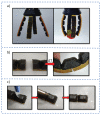Humins Blending in Thermoreversible Diels-Alder Networks for Stiffness Tuning and Enhanced Healing Performance for Soft Robotics
- PMID: 35566827
- PMCID: PMC9101211
- DOI: 10.3390/polym14091657
Humins Blending in Thermoreversible Diels-Alder Networks for Stiffness Tuning and Enhanced Healing Performance for Soft Robotics
Abstract
Humins waste valorization is considered to be an essential pathway to improve the economic viability of many biorefinery processes and further promote their circularity by avoiding waste formation. In this research, the incorporation of humins in a Diels-Alder (DA) polymer network based on furan-maleimide thermoreversible crosslinks was studied. A considerable enhancement of the healing efficiency was observed by just healing for 1 h at 60 °C at the expense of a reduction of the material mechanical properties, while the unfilled material showed no healing under the same conditions. Nevertheless, the thermal healing step favored the irreversible humins polycondensation, thus strengthening the material while keeping the enhanced healing performance. Our hypothesis states a synergistic healing mechanism based on humins flowing throughout the damage, followed by thermal humins crosslinking during the healing trigger, together with DA thermoreversible bonds recombination. A multi-material soft robotic gripper was manufactured out of the proposed material, showing not only improved recovery of the functional performance upon healing but also stiffness-tunable features by means of humins thermal crosslinking. For the first time, both damage healing and zone reinforcement for further damage prevention are achieved in a single intrinsic self-healing system.
Keywords: Diels–Alder; biomass valorization; green composites; humins; immiscible blends; mild healing; self-healing; soft robotics; stimuli-responsive; thermoreversible.
Conflict of interest statement
The authors declare no conflict of interest.
Figures








References
-
- de Jong E., Dam M., Sipos L., Gruter G., Smith P., Gross R. Furandicarboxylic Acid (FDCA), A Versatile Building Block for a Very Interesting Class of Polyesters. Biobased Monomers Polym. Mater. 2012;1105:1–13.
-
- Nolasco M., Araujo C., Thiyagarajan S., Rudic S., Vaz P., Silvestre A., Ribeiro-Claro P., Sousa A. Asymmetric Monomer, Amorphous Polymer? Structure-Property Relationships in 2,4-FDCA and 2,4-PEF. Macromolecules. 2020;53:1380–1387. doi: 10.1021/acs.macromol.9b02449. - DOI
-
- Pfab E., Filiciotto L., Luque R. The Dark Side of Biomass Valorization: A Laboratory Experiment To Understand Humin Formation, Catalysis, and Green Chemistry. J. Chem. Educ. 2019;96:3030–3037. doi: 10.1021/acs.jchemed.9b00410. - DOI
Grants and funding
LinkOut - more resources
Full Text Sources

